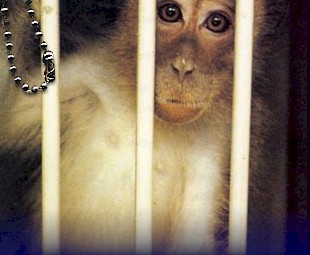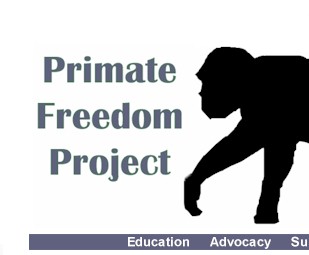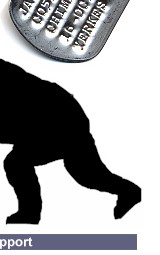






|
||||||||||||||||||||||||||||||||||||||||||||||||||||||||||||||||||||||||||||||||||||||||||||||||||||||||||||||||||||||||||||||||||||||||||||||||||||||||||||||||||||||||||||||||||||||||||||||||||||||||||||||||||||||||||||||||||||||||||||||||||||||
California National Primate Research Center CNPRC 2003/04 Annual Progress Report If you are wearing a Primate Freedom Tag, the monkey on your tag may be a research victim at the California National Primate Research Center (CNPRC) in Davis, California. Many hundreds of people are wearing primate Freedom Tags from the CNPRC. Over 3300 primates including squirrel monkeys, pig-tailed macaques, bonnet macaques, crab-eating macaques, rhesus macaques, and titi monkeys are experimented on day in and day out. This is a sad place.
CRPRC has been surprisingly responsive to the letters and phone calls from Primate Freedom Tag wearers requesting information about the primate on their Freedom Tag. They seem to see nothing wrong with harming animals shown, repeatedly, to have minds and emotions very like our own. Read about the types of research (below) being funded by the National Institutes of Health conducted at the CNPRC. Most researchers (e-mail addresses provided) are conducting many studies at any one time. And you, as taxpayers, are paying their salaries. There are over 160 NIH funded projects underway at the moment. AMARAL, DAVID G. <dgamaral@ucdavis.edu> damages areas of monkeys' brains and then watches how they get along with other monkeys. He is planning to remove specific regions of the brains of neonatal monkeys and hopes that they will seem autistic as they mature. (Meet David!) BARRY, PETER A. < pabarry@ucdavis.edu > reports on his dissection of a young rhesus monkey he killed which had been ill with a disease specific to rhesus macaques. BARTHOLD, STEPHEN W. <swbarthold@ucdavis.edu> trains students to be vivisectors. BRITTEN, KENNETH H. < khbritten@ucdavis.edu > says, "[W]e train monkeys on tasks demanding the analysis of visual motion, and precisely measure the signals in these cortical areas with single cell recording techniques, or alternatively, we perturb the signals in these areas using very small electrical [shocks to their brain], and measure the effects on the animals' behavior." (Meet Ken!) BUCKPITT, ALAN < arbuckpitt@ucdavis.edu > is forcing rhesus macaques to inhale toxic chemicals. He states, "Although cigarette smoking is a major etiologic factor in these [lung] diseases, exposure to chemicals in the workplace and in the environment may be important as well." CANFIELD, DON R. < drcanfield@ucdavis.edu > reports, "We are in the process of attempting to infect rhesus macaques with human strains of H pylori." It is believed that H pylori is a cause of some gastric ulcers. CAPITANIO, JOHN P. < jpcapitanio@ucdavis.edu > is sucking up AIDS research dollars by attempting to determine whether rhesus monkeys with certain personalities will get sicker and die more quickly of SIV than monkeys with different personalities. Capitanio is worthy of considerable scrutiny. As the president of the American Society of Primatologists he is an exemplar of what primate researchers see as the epitome of a "good scientist." A good starting point for understanding what this really means is his recent paper: "Cognitive style: problem solving by rhesus macaques (Macaca mulatta) reared with living or inanimate substitute mothers." (Meet John!) CHALUPA, LEO M. < lmchalupa@ucdavis.edu > studies eye development in macaque monkey embryos.(Chalupa's bio.) CHRISTE, KARI <klchriste@primate.ucdavis.edu> notes, "Measles is a highly infectious paramyxovirus that can cause an epizootic with almost 100% morbidity and up to 27% mortality in rhesus macaques. Due to the cost prohibitive nature of measles vaccination, many primate facilities elect not to immunize their colonies." Christe is trying to determine whether "canine distemper-measles vaccine was as effective as the currently used, but cost-prohibitive, measles vaccine in protecting rhesus macaques." CHUANG, RONALD Y. <rychuang@ucdavis.edu> "Using the simian immunodeficiency virus (SIV) and rhesus monkeys (Macaca mulatta) as an animal model system for studying viral pathogenesis and AIDS, the objective of the current proposal is to continue our previous studies in evaluating the effects of morphine dependence on the viremia and on disease development after inoculation with SIVmac239, a molecular clone of SIV." COWAN, MORTON J. is transplanting kidneys in young monkeys. He notes, "...solid organ transplantation in children is plagued by organ shortage, rejection, and complications of immunosuppression." and then goes on to report that, "...control animals showed sonographic and histologic evidence of severe, acute rejection with massive cortical necrosis and graft failure one week post-transplant." This is the typical blood sacrifice to the alter of sacred Science. DANDEKAR, SATYA < sdandekar@ucdavis.edu > is another of the multitude of researchers infecting rhesus macaques with SIV to record various parameters of their resultant decline toward death. DEGREGORIO, MICHAEL W. < mwdegregorio@ucdavis.edu > is studying two drugs currently used to treat breast cancer in humans. He reports, "[W]e have treated a number of rhesus macaques with tamoxifen and toremifene, and we have biopsied the livers and uteri of these animals during treatment." Typically, such biopsies are repeated frequently. EBERLING, JAMIE L.<jleberling@lbl.gov> is trying to determine whether PET scans can be used to monitor the results of brain injections of nerve growth factor in aged monkeys of some undisclosed species. ENAS, JOEL D. writes: "The primate model is well suited for preclinical PET studies based on the anatomic and functional similarities with the human brain." With the chemicals he is studying, he "had previously demonstrated uptake in the rat brain.... When studied in the primate, we found that there was little or no radioactivity localized in the brain. These compounds were not able to cross the blood brain barrier. While this result was unexpected it is not totally surprising as the distribution of radiophamaceutical can be highly species dependent." ENDERS, ALLEN C. < acenders@ucdavis.edu > is subjecting female rhesus monkeys to hours of chemical (?) restraint while monitoring a model of the early stages of embryo implantation in the uterine wall. FULLER, CHARLES A. < cafuller@ucdavis.edu > wins the Egregiously Meaningless Research Dollar Squander Award. He locked rhesus monkeys into a cyclotron and spuns them for months (?) to create an environment with twice the normal gravitational force. Prior to locking monkeys into this spinning prison cell he surgically implanted telemetry which allowed him to, "record PTS , video, temperature, heart rate, activity and drinking continuously, as well as to collect urine, from rhesus individually housed on this centrifuge." PTS is the psychomotor test system developed at the University of Georgia Language Research Center. He was able to vary the amount of light exposure the monkeys received. He wrote: "We designed and built dipole antennae contained within PVC piping. As an additional benefit, they are used as a perch, providing an additional source of environmental enrichment." As if he cared. [Meet Chuck!] GARDNER, MURRAY B. <mbgardner@ucdavis.edu> continues to test new SIV vaccines. Monkeys he has made sick are still dying. GERSHWIN, LAUREL J. <ljgershwin@ucdavis.edu> says, "The objective of this preliminary study is to develop a primate model to study human respiratory syncytial virus (RSV) infection... To develop this model we used a mouse-adapted human RSV isolate and infected an infant rhesus monkey by aerosol. The monkey was monitored daily for development of clinical signs and virus shedding was evaluated daily by culturing swabs taken from the nasal cavity. Results: The monkey failed to become infected." GILBERT, WILLIAM < wmgilbert@ucdavis.edu > states, "Four chronically catheterized rhesus monkey fetuses at 125q0.5 days of gestation with ligated esophagi and catheterized trachea were studied. Radioactive technetium -99m (TC -99m ) was injected into the amniotic cavity followed by a series of blood and [amniotic fluid] withdrawals over a period of four hours to tract the distribution of the radioactivity." GOLUB, MARI S. < msgolub@ucdavis.edu > is force feeding aluminum to pregnant guinea pigs and adding aluminum to the food of mice. GRAY, CHARLES M. <cmgray@ucdavis.edu> Places electrodes into cats' and monkeys' brains. He is studying vision. He says the results from these experiments will lead to more experiments. HAVEL, PETER J. < pjhavel@ucdavis.edu > reports that, "Leptin is a newly discovered hormone." And what should be done with a recently discovered hormone? Havel has received public funds to inject it into obese and lean rhesus monkeys which are locked in cages in sealed chambers equipped with flowmeters and instruments for measuring oxygen and carbon dioxide. HENDRICKX, ANDREW G. < aghendrickx@ucdavis.edu > poisons fetal macaques. HITCHCOCK, MARGARET E. < mehitchcock@ucdavis.edu > reports that a vaccine against the virus which causes human genital warts can be positively affected when used in conjunction with cholera toxin. Unfortunately, her time has been spent studying human genital warts in rhesus macaques which seem unaffected by cholera. Humans on the other hand... HORTON, JONATHAN C. takes infant monkeys by cesarian to study their eye development. HUFFMAN, KELLY J. is interested in the area of rhesus and marmoset brains associated with bilateral coordination of the hands and manual dexterity. To pusue his interest, he in implanting eletrodes into their brains and injecting various chemicals into them. He claims that, "The results of these experiments will provide critical information on a cortical area that may be involved in the integration of somatic inputs and motor outputs." Sounds like double talk. HYDE, DALLAS M. < dmhyde@ucdavis.edu > damages rhesus monkeys' lungs with ozone. Then he kills them. JACOBS, GERALD H. Writes, "A noninvasive electrophysiological procedure, electroretinogram flicker photometry, was used to measure the photopigments in Titi monkeys." Titis are notable for their gentleness. While Jacobs' study many be "noninvasive" in the sense that he is not performing surgery on the monkeys, he must be restraining them during his experiments. Electroretinogram flicker photometry recordings are made by embedding an electrode in a contact lens and placing a reference electrode at some other convenient place on the head. JAGUST, WILLIAM < wjjagust@lbl.gov > is testing an experimental radiographic tracer in six rhesus monkeys. He chemically damaged two of the monkeys' brains for his tests. (Will's bio.) KRUBITZER, LEAH A. <lakrubitzer@ucdavis.edu> "Complex behaviors and cognitive process such as those observed in humans and other primates are marked by increases in brain size, particularly in the forebrain.... The purpose of the present proposal is to investigate some aspects of forebrain expansion in the somatosensory system in two species of primates, macaque monkeys and marmoset monkeys..." Essentially, she plans to put electrodes into their brains and inject some chemicals into their brains as well. Interestingly, she says she will be using two primate species, but her abstract lists three: Callithricidae, Macaca fascicularis, and Macaca mulatta. LASLEY, BILL L. < bllasley@ucdavis.edu > is using crab-eating macaques as he tests various anti-fertility vaccines for use in underdeveloped countries. LERCHE, NICHOLAS W. < nwlerche@ucdavis.edu > reports, "SRV/D is a serious pathogen of macaques, causing significant morbidity and mortality secondary to viral-induced immune suppression.... A small group of naturally infected macaques are maintained to develop and validate new diagnostic methods." This is similar to keeping syphilitic humans around so we can develop and validate new diagnostic methods. LONNERDAL, BO < bllonnerdal@ucdavis.edu > measured iron and copper levels in 24 infant rhesus macaques fed on three different infant formulas. Lonnerdal reports, "Further studies are needed in human infants to verify the findings." Why were the monkey studies needed at all? LUCIW, PAUL A. < paluciw@ucdavis.edu > is another federal welfare recipient paid to kill monkeys with SIV . MARTHAS, MARTA L. < mlmarthas@ucdavis.edu > writes, "Infants were inoculated orally with a high dose of SIV within 3 days of birth. This oral dose of SIV infected four naive neonatal rhesus macaques and all developed high virus levels in peripheral blood and fatal immunodeficiency." These four babies were the blood sacrifice to $cience. Marthas knew, as she infected them, that she was killing them in a manner which would cause long-term suffering. In the government funded religion of $cience, blood sacrifice is termed: the control. MASON, WILLIAM A. < wamason@ucdavis.edu > In what is likely labeled part of CRPRC¹s conservation effort, Mason states, "Behavioral and physiological responses to varying periods of separation from the pairmate and effects of separation on responses to strangers and to reunion with the pairmate have been examined." He screws with squirrel and titti monkeys. Mason is a past president of the American Society of Primatologists, a past student of harry harlow's and a coauthor of the paper cited in John Capitanio's entry above. MENDOZA, SALLY P. < spmendoza@ucdavis.edu > uses the term "psychological well-being" in the title of one of her projects, but seems intent on determining how to increase reproductive rates of squirrel monkeys. The resulting increased infant production and resultant increase in torture to these babies underscores the fallacious nature of any studies purporting to study psychological well-being at the RPRCs. Sally's new study exposes the reality of her interests. She writes, "We have identified two simple social manipulations that result in long-term disruption of pituitary-adrenal regulation. Mate separation in titi monkeys produces long-term elevations in cortisol; group formation in squirrel monkeys produces long-term reductions in cortisol. Comparison of the two species affords a unique opportunity to ask whether chronic stress subsumes multiple distinct syndromes." MC CHESNEY, MICHAEL B. < mbmcchesney@ucdavis.edu > plans to infect some rhesus macaques with SIV and others with measles. He will compare the disease progression and document the expected recoveries from measles and expected deaths from SIV. MCCOWAN, BRENDA. is studying chuck calls in squirrel monkeys. She suggests that learning may play an important role in the acquisition of communication skills in squirrel monkeys. MCDONALD, RUTH J. < ruth.mcdonald@ucdmc.ucdavis.edu > has discovered that instilling free DNA directly into rhesus macaques' lungs does not seem to harm them. She discovered this by killing monkeys after the infusion and examining their lungs. MERRITT, T. ALLEN cut a hole in the windpipes of new born infant rhesus macaques and squirted their feces into their lungs. This caused pneumonia. Some babies he tried to cure. Others he allowed to die to make sure that the natural laws of the universe had not changed recently. Merritt seems not to be receiving any federal funding at the moment. He is now working at St. Charles Medical Center and Central Oregon Pediatric Associates in Bend, Oregon. MILLER, CHRISTOPHER J. < cjmiller@ucdavis.edu > is into the big-time AIDS money. He had 15 funded studies underway in 2000. A few titles: VAGINAL TRANSMISSION OF SIV; VAGINAL IMMUNOLOGY IN MENSTRUAL CYCLES; SIV CHALLENGE OF SHIV [SHIV is a laboratory creation which combines HIV and SIV] INOCULATED RHESUS MACAQUES: VAGINAL TRANSMISSION; IMMUNIZATION AGAINST GENITAL TRANSMISSION OF SIV; IMMUNIZATION AGAINST GENITAL TRANSMISSION OF SIV; HETEROSEXUAL TRANSMISSION OF AIDS SIMIAN MODEL; COMPARISON OF IV VERSUS MUCOSAL INOCULATION W/ SIV; and on and on. MURPHY, FREDERICK A. <famurphy@ucdavis.edu> seems to be charged with oversight of the center's colony of "aging monkeys". MYLES, DIANA G. <dgmyles@ucdavis.edu> On a planet reeling from the demands of over six billion humans, Myles is spending her time attempting to improve the success of "assisted reproduction". Simultaneously, she is trying to develop a sperm immunization for use as birth control by men. She is testing this on monkeys. OSBURN, BENNIE I. <biosburn@ucdavis.edu> "The California Regional Primate Research Center (CRPRC) does not currently have adequate facilities to conduct Biosafety Level 3 (BSL-3) research, due to lack of BSL-3 animal housing space.... This facility is necessary to provide animal research space to accommodate expanding research programs in tuberculosis, Borna Disease virus, as well as new viral vectors in gene therapy research. In addition, the new BSL-3 space will allow for expansion of CRPRC's retroviral research program into further research with recombinant HIV, SIV and viral co-infections with SIV infected animals." OVERSTREET, JAMES W. < jwoverstreet@ucdavis.edu > is hoping to develop a vaccine against macaque sperm. Is he worried about becoming infected? PINKERTON, KENT E. < kepinkerton@ucdavis.edu > forces monkeys to inhale dust for 28 days at a time. He then studies the damage to their lungs. PLOPPER, CHARLES G. < cgplopper@ucdavis.edu > writes, "The overall goal of [my] project is to define the mechanisms of acute injury to the respiratory system [in the rhesus monkey] produced by inhalation of oxidant air pollutants, such as ozone, and to define the process by which the respiratory system develops tolerance to further injury when exposure continues." RECANZONE, GREGG H. < ghrecanzone@ucdavis.edu > plans to teach monkeys to discriminate between certain sounds in two different ways. He then intends to damage small areas of their brains to see whether they can perform one trick better than the other. He says that he really has no idea what will happen. (Recanzone's bio.) JACK, RICK is trying to find a way to transplant pig organs into rhesus monkeys without killing them. He is testing an experimental concoction that he hopes will stop organ rejection. He will treat three monkeys for 60 days with the chemical, run a few tests and then transplant a pig kidney into them. He hopes they will live for a while. At the same time, he will transplant a pig kidney into a fourth monkey who has not had the treatment. He knows this will kill this monkey. And probably the pig. REEDER, DEEANN M. "This study proposes to examine the effects of repeated or chronic stress in squirrel monkeys (Saimiri sciureus) and titi monkeys (Callicebus moloch).... Although many aspects of the response to acute stress has been characterized in these species, the ability to compensate for the glucocorticoid rise associated with the stress response has not been studied nor has the consequences of chronic exposure to stressors. I will separate animals from their social group and place them in a novel environment daily for eight weeks in order to examine both the transient and permanent effects of repeated psychological stress in adult monkeys" Deeann is a graduate student. ROBERTS, JEFFREY A. < jaroberts@ucdavis.edu > has tested 55 aged rhesus monkeys' learning and memory abilities and compared the results with young monkeys. He has determined that both groups seem equally able to learn, but old monkeys¹ memories are less efficient. Duh. SALOMON, DANIEL R. "We started by creating a new strategy to render the monkeys diabetic and insulin-dependent. After 4 weeks, two insulin-dependent monkeys were transplanted intrathymically with human fetal islets... The animals are presently just 3 months post transplant, healthy and clinically stable. We have learned alot about insulin therapy, dosing, and complications of the cyclosporine and RAD as well as gained experience caring for immunosuppressed animals." SMITH, DAVID GLENN < dgsmith@ucdavis.edu > is attempting to discover just how interrelated the Center's rhesus monkeys are to each other. Wouldn't one expect a major breeder of monkeys to have maintained detailed breeding records? SMITH, LLOYD H. <lhsmith@ucdavis.edu> states, "The long term objective of this research is to establish a reliable nonhuman primate model for human papillomavirus ( HPV) genital tract infection and disease." SOLNICK, JAY V. <jvsolnick@ucdavis.edu> "Eleven rhesus monkeys were hand reared from birth and documented by endoscopy, serology, and urea breath test to be free of infection with H. pylori. The animals were randomly divided into a control group (N=2), a group receiving oral urease with E. coli LT adjuvant (N=4), and a group receiving intramuscular urease with a novel adjuvant (N=5). Immunizations were delivered a total of 4 times, followed 1 week later by challenge with H. pylori derived from rhesus monkeys. Three weeks after immunization the animals were endoscoped and biopsies were obtained for quantitative culture and histology. All animals also underwent repeat urea breath testing. The results indicated that all animals were infected to varying degrees. There was no relationship between quantitative culture and immunization, or between gastric mucosal inflammation and immunization. These results indicate that previous data in mice which suggested that urease might serve as an effective vaccine may not be relevant to primates." [emphasis added. It should be noted that Solnick attemps to generalize his results from eleven rhesus monkeys to the entire Order which includes over 200 species. Most primate vivisectors make the same claims.] SRETAVAN, DAVID W. comments, "Prior investigations have indicated that one retina from a rhesus monkey fetus contains roughly 1.6 million retinal ganglion cells. The combined total of 3.2 million retinal ganglion cells from both eyes of one fetus should provide ample tissue for the isolation of gene fragments. Retinal tissues from a rhesus monkey fetus are currently being processed in this study for gene identification." After all, what's one more baby monkey? TARANTAL, ALICE F. < aftarantal@ucdavis.edu > is tickled pink about her discovery that chronic dosing (daily? hourly? a continuous drip?) of nitric oxide synthase to a pregnant monkey (of some unnamed species) causes her baby to quit growing normally. TUSZYNSKI, MARK H. plans to damage the spinal chord of four monkeys to cause paralysis in one leg. He will then inject nerve growth factor into that region of their spinal chord to see whether it fixes them up. He has been performing similar experiments since 1975. VALVERDE, CELIA R. < crvalverde@ucdavis.edu > experiments with various chemicals for use as anesthesia in macaques. VANDEVOORT, CATHERINE A. < cavandevoort@ucdavis.edu > is using crab-eating macaques to search for a sperm vaccine. The injection sites are prone to develop chronic inflammatory lesions (non-healing swollen sores). VAN ROMPAY, KOEN K. A. < kkvanrompay@ucdavis.edu > reports, "...we inoculated 12 newborn macaques with PMPA- resistant SIVmac and six animals were started on PMPA- treatment at 3 weeks of age. The six untreated animals had high viremia, rapid immunosuppression and died between 7 and 14 weeks of age." More blood sacrifice to $cience. VERSTRAETE, FRANK J.M. <fjverstraete@ucdavis.edu> "The California Regional Primate Research Center routinely performs crown amputation with vital pulpotomy on maxillary canine teeth of adult male (- 7 years of age) rhesus macaques in order to reduce self-trauma and injury to staff or cage-mates. The failure rate of this procedure is anecdotally high at the CRPRC... Crown amputation with pulpotomy on maxillary canine teeth was performed on 7 animals, and subgingival amputation on 13 animals. The preliminary results indicate an unacceptably high failure rate of the latter procedure, and this technique will not be used any further. Appropriate therapeutic measures were taken to treat the affected animals." WINE, JEFFREY is analyzing macaque DNA in the hope that mutations can be found and reinforced through selective breeding which will mimic human genetic disease. He envisions colonies of monkeys with genetic illnesses. YILMA, TILAHUN <tdyilma@ucdavis.edu> infects newborn macaques with SIV.
Fetal Surgery in the Primate: III. Maternal Outcome after Fetal Surgery (Adzick) [From the Physician's Committee for Responsible Medicine's examination of March of Dimes funded research.] This experiment looked at maternal safety in a series of in utero fetal surgeries that were performed on 94 pregnant monkeys. There were different types of fetal surgery, including 46 cases where either a urinary tract obstruction or hydrocephalus was created in the fetus as part of other experimental protocols. Another 26 involved chronically chair-restrained mothers with electrodes implanted into the uterus to monitor uterine activity in response to drugs and different surgical procedures. Monkeys were "conditioned" to restraining chairs in a routine of five days of chair restraint followed by two days of caging. In the experiments designed to look at uterine activity, there was a fetal death rate of 89 percent which the researchers partly attributed to the "profound combined insult of maternal restraint, fetal surgery, and chronic catheterization of the uterus," effects which had been previously documented by other researchers. The experimenters note that the drug regimens to prevent uterine contractions may have been ineffective because of the magnitude of these stimuli. (It should be noted that although the papers describing these individual experiments did not mention funding by the March of Dimes, these experiments were part of the March of Dimes-supported research paper, Fetal Surgery in the Primate III, which looked at the maternal outcome of these experiments.) This current paper, Fetal Surgery in the Primate III, examined
maternal complications after fetal surgical procedures done on 94
pregnant monkeys. This paper did receive funding from the March
of Dimes. The authors concluded that, although serious maternal
complications occurred, many are avoidable. There were three maternal
deaths, five uterine ruptures, and five cases of wound infection
or dehiscence. One "anesthesia-related death occurred during a case
in which there was no designated anesthesiologist." The authors
add, "Another maternal death secondary to eclampsia was also avoidable,
since vigilant monitoring of maternal blood pressure was not performed
after the immediate post-operative period. Of note, monkeys are
quite susceptible to both eclampsia and abruptio placenta." There
were five cases of uterine rupture, three of which‹including one
that resulted in maternal death‹were due to "technical failure of
a prototype absorbable staple device." The two uterine ruptures
not due to technical failure of the staple device occurred during
term labor. The authors concluded that "cesarean section delivery
should be mandatory after fetal surgery to avoid rupture of the
relatively fresh uterine wound." All animals had been obtained from the California Primate Research
Center, Davis, California.
Home Page | Our Mission | News |
